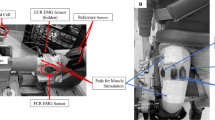Conclusions
Within the limits of this study as carried out with the above technique, it would seem logical to draw the following conclusions:
-
1.
Amplitude increases as muscle tension increases.
-
2.
The rate and amplitude of the tremors are fairly constant throughout the day.
-
3.
There is an inverse relationship between rate per second and the amplitude in millimeters.
-
4.
The changes which took place involve the amplitude to a greater extent than the rate per second.
Similar content being viewed by others
Bibliography
Eshner, A. A.: J. of exper. Med.2, 301–312 (1897).
Binet, Leon: Lancte198, 265/266 (1920).
Herron, R. Y.: J. of exper. Psychol.15, 87–96 (1932).
Bousfield, W. A.: J. of exper. Psychol.15, 104–107 (1932).
Travis, L. E. andTheodore Hunter: Genet. Psychol. Monogr.6, 255–261 (1931).
Young, I. C.: J. of exper. Psychol.16, 644–656 (1933).
Travis, L. E.: J. of exper. Psychol.12, 515–524 (1929).
Author information
Authors and Affiliations
Rights and permissions
About this article
Cite this article
Tuttle, W.W., Voltmer, E.J. A study of factors affecting neuro-muscular tremors. Arbeitsphysiologie 10, 530–533 (1939). https://doi.org/10.1007/BF02012170
Received:
Issue Date:
DOI: https://doi.org/10.1007/BF02012170




